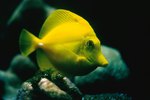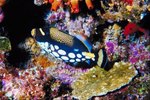Due to their coloring and general shape, red-bellied pacus are often mistaken for their cousins, red-bellied piranhas. However, as herbivores, pacus have quite different diets than their notoriously flesh-eating relatives. Red-bellied pacus grow up to 30 inches long -- although aquarium specimens rarely exceed 12 inches -- so you should only attempt to keep one if you have a large aquarium of at least 250 gallons.
Wild Diet
Red-bellied pacus originate from the river basin of both the Rio Orinoco and the Amazon. In the wild, they're primarily herbivores, which means they eat plants and vegetation. They'll eat any fruits, nuts and seeds they can find. In fact, their hard, flattened teeth are specially designed to be able to crush nuts and seeds. However, they're opportunistic feeders, so they'll occasionally eat non-plant foods if they come across them. Other foods they may eat in the wild include insects, small fish and zooplankton.
Packaged Foods
Part of your red-bellied pacu's diet in a home aquarium will be packaged commercial foods. His diet should be partially made up of a high-quality pellet or stick food. An adult of the species requires these bigger pellet or stick foods to thrive. However, if you have a juvenile, he will do fine on a diet of commercial fish flakes. If you're unsure which brand is most suitable for your fish, consult your regular aquarium supply store.
Fresh Foods
In addition to commercial foods, your red-bellied pacu will need to eat a range of fresh foods. A varied diet is important to keep him healthy. Feed the same fruits and vegetables that a person would need to stay healthy, such as broccoli, spinach, peas, banana, apple and grapes. Unlike other pacus, red-bellied pacus will accept seeds and smaller nuts, such as hazelnuts or cashews. Make sure their food is chopped into roughly bite-size pieces. As these fish like to eat vegetation, any plants in your tank are likely to be devoured. Instead offer pieces of wood for cover.
Amount and Frequency
As with other pacu fish, feed a red-bellied pacu once every day. As a general rule, feed only as much as he can eat in two to three minutes. If there's any food left over, skim it out of the tank to avoid it degrading the water quality. However, when feeding fresh fruits and vegetables, you can leave these in the tank for a couple of hours after feeding before they start to decay.





